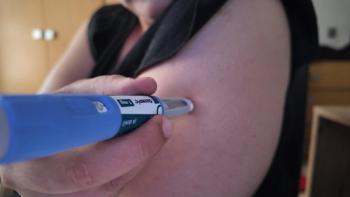
Bridging Therapy Responses May Outcomes With Axi-Cel Administration in Real-World Setting
High disease burden may be associated with more bridging therapy use and contribute to worse outcomes, according to investigators.
The use of bridging therapy prior to starting axicabtagene ciloleucel (Yescarta; axi-cel) did not improve efficacy or safety outcomes for patients with relapsed/refractory large B-cell lymphoma (LBCL), recent findings demonstrated.
Regardless, responses to bridging therapy may be indicative of their anticipated outcomes after axi-cel administration, according to findings from a real-world Center for International Blood and Marrow Transplant Research (CIBMTR) observational database analysis that were presented during the
Findings from the real-world study showed that the overall response rate (ORR) with axi-cel in patients who received bridging therapy was 70%, including a complete response (CR) rate of 51%. In comparison, patients who did not undergo bridging therapy experienced an ORR of 79%, with a CR rate of 64%. The 3-year duration of response (DOR) rates in the bridging therapy and non–bridging therapy arms were 40% and 49%, respectively. The rates of relapse or progressive disease (PD) at 3 years were 62% and 49% in patients who received and did not receive bridging therapy, respectively.
The median progression-free survival (PFS) and overall survival (OS) was 3.6 months (95% CI, 3.2-4.8) and 13.4 months (95% CI, 10.7-18.6), respectively, in patients who received bridging therapy; these measures were 14.7 months (95% CI, 10.3-19.1) and 32.7 months (95% CI, 27.4-41.1) in those who had not received bridging therapy.
However, after inverse probability of treatment weighting (IPTW) and multivariable adjustment for patients and disease imbalances at baseline, no significant difference in all effectiveness outcomes of axi-cel was found between the bridging therapy and non–bridging therapy arms. The adjusted ORs/HRs for ORR, PFS, and OS were 0.81, 1.13 (95% CI, 0.94-1.36), and 1.11 (95% CI, 0.92-1.34), respectively. The respective adjusted ORs/HRs for CR, relapse/PD, and DOR were 0.80, 1.19, and 1.10.
“In the initial assessment of all patients in this real-world study, high disease burden was associated with more bridging therapy use and may have contributed to worse outcomes,” lead study author Michael R. Cook, MD, an assistant professor of Clinical Medicine (Hematology-Oncology) at the Perelman School of Medicine at the University of Pennsylvania in Philadelphia, stated in a presentation of the data. “In contrast to Kaplan-Meier curves [in all patients, however,] the adjusted survival curve [after IPTW] shows no statistical difference in the PFS and OS of the IPTW bridging therapy vs non–bridging therapy groups.”
The use of axi-cel in LBCL expanded considerably after the agent demonstrated superior event-free survival and response rates vs the standard of care for patients with early relapsed or primary refractory LBCL in the phase 3 ZUMA-7 trial (NCT03391466). Subsequently reported survival data from ZUMA-7 reinforced the demand for this agent in clinical practice, but there are still limited data on the impact of bridging therapies on patient outcomes with axi-cel.
Accordingly, the decision to utilize bridging therapy prior to lymphodepletion is largely up to the treating physician’s discretion. To address this need, investigators assessed the influence of bridging therapies on effectiveness and safety outcomes following axi-cel administration.
A post-authorization safety study prospectively collected data from adult patients with LBCL who were treated with axi-cel in the third-line or later settings in the United States between 2017 and 2020 through the CIBMTR registry. The data cut-off for the current analysis was May 4, 2023, and the median follow-up was 36 months.
Primary efficacy outcomes of interest included ORR, CR, DOR, PFS, relapse/progression, and OS. Key safety outcomes of interest were cytokine release syndrome (CRS) and immune effector cell-associated neurotoxicity syndrome (ICANS) graded per ASTCT criteria; prolonged thrombocytopenia and neutropenia; non-relapse mortality (NRM); and clinically significant infections.
Logistic and Cox regressions utilized propensity score–based IPTW to account for potential confounding in bridging therapy use when estimating adjusted effects. The effect of bridging therapy types and responses on patient outcomes was also evaluated using conventional logistic and Cox regressions.
A total of 1497 patients matching these criteria were initially identified. Of these, 190 patients were excluded from the study. Reasons for exclusion included incomplete baseline and follow-up data forms (n = 81); primary central nervous system lymphoma, Richter’s syndrome, or other type of B-cell lymphoma (n = 43); missing data on bridging therapy (n = 33); prior non–hematopoietic cell transplantation cellular therapy (n = 31); and no effectiveness or safety follow-up data (n = 2).
Following exclusions for missing data, the all-patient cohort was made up of 1307 patients. In the all-patient cohort, 430 patients had previously received bridging therapy, and 877 patients had not. The IPTW cohort had a weighted patient total of 1213, which included 410 patients in the bridging therapy arm and 803 patients in the non–bridging therapy arm. Weighted exclusion criteria for the all-patient cohort consisted of propensity scores for receiving therapy outside the support region, with values less than 0.05 or greater than 0.95. This allowed for the appropriate matching of cohorts.
In the overall cohort, the minority of patients were 65 years of age or older (33% in bridging therapy arm; 39% in non–bridging therapy arm). An ECOG performance status (PS) of 2 or greater prior to infusion was seen in 7% and 4% of patients, respectively. Twenty-eight percent of patients in both arms experienced histologic transformation, and bulky disease prior to infusion was seen in 6% and 4% of patients in these respective arms. Mild hepatic impairment occurred in 12% and 8% of patients. Most patients had received 3 or more prior lines of therapy (92%; 57%), were refractory to their last line of therapy before leukapheresis (91%; 83%), and had a time from diagnosis to leukapheresis of less than 12 months (52%; 44%). Twenty-four percent and 31% of patients in the bridging and non–bridging arms, respectively, underwent infusion from 2018 to 2020.
In the IPTW cohort, 35% of patients were 65 years of age or older in the bridging therapy arm vs 36% of patients in the non–bridging therapy arm. The minority of patients had an ECOG PS of 2 or greater prior to infusion (6% in the bridging therapy arm; 7% in the non–bridging therapy arm), mild hepatic impairment (8%; 9%), and bulky disease prior to infusion (4%; 5%). Histologic transformation was experienced by 27% and 28% of patients, respectively. Most patients had received 3 or more prior lines of therapy (73%; 75%), and 89% of patients each in both the bridging and non–bridging groups were refractory to their last line of therapy. The percentages of patients who had a time from diagnosis to leukapheresis of less than 12 months were 48% and 49%. Twenty-eight percent and 27% of patients in the bridging and non–bridging arms, respectively, underwent infusion from 2018 to 2020.
Multivariate logistic regression showed that patients with mild hepatic impairment, 3 or more lines of prior therapy, or axi-cel infusion in 2019 or 2020 were more likely to have received bridging therapy vs patients with histologic transformation or a longer time from diagnosis to leukapheresis.
Distribution of all characteristics for patients with or without bridging therapy were balanced after IPTW (standard mean difference < 0.10).
An assessment of bridging therapy types in patients who received bridging therapy revealed that 58% of patients were treated with chemotherapy plus an anti-CD20 monoclonal antibody, 23% of patients received a non-chemotherapy bridging therapy, 13% of patients received chemotherapy without an anti-CD20 monoclonal antibody, and 10% of patients received radiotherapy with or without systemic therapy. The most common systemic bridging therapies were gemcitabine-oxaliplatin plus rituximab (Rituxan; 17%); polatuzumab vedotin-piiq (Polivy)–based regimens (13%); and rituximab plus ifosfamide, carboplatin, and etoposide phosphate (7%).
A safety analysis after IPTW showed that patients who did and did not undergo bridging therapy had similar rates of CRS (12% with bridging therapy; 10% without bridging therapy), ICANS (30%; 24%), infections at 100 days, (34%; 29%), and NRM 1 year after axi-cel infusion (5%; 5%). However, the use of bridging therapy was associated with a higher incidence of prolonged neutropenia, at 12% vs 5%, respectively (adjusted OR, 2.23 [95% CI, 1.44-3.50]). Prolonged thrombocytopenia was also observed in this group in 36% and 16% of patients, respectively (adjusted OR, 2.33 [95% CI, 1.67-3.24]).
An additional efficacy assessment showed that patients who experienced a response with bridging therapy experienced increased CRs (HR, 2.00), median PFS (HR, 0.69), and median OS (HR, 0.59). Moreover, the frequency of any-grade ICANS events following axi-cel administration decreased in this population (HR, 0.51). Seventeen percent of patients who underwent bridging therapy experienced a CR or partial response to bridging therapy. The adjusted median PFS for these patients post-infusion with axi-cel was 12 months, with an adjusted median OS that was not reached.
Outcomes with axi-cel according to the type of bridging therapy administered showed that effectiveness and most safety outcomes were comparable between patients treated with anti-CD20 monoclonal antibody therapy and chemotherapy vs non-chemotherapy bridging therapy. Patients treated with the former regimen also experienced superior ORR, PFS, and OS with axi-cel vs those treated with non-chemotherapy regimens; however, they also experienced more frequent any-grade CRS compared with those who received chemotherapy-only bridging therapy.
Patients who received chemotherapy as bridging therapy also experienced a greater incidence of prolonged thrombocytopenia (41%) vs those who received non-chemotherapy bridging therapy (24%). The use of radiotherapy or polatuzumab vedotin was not found to be significantly associated with outcomes following axi-cel infusion.
“Further studies are warranted to validate these findings and are needed to identify the optimal bridging regimen,” Cook concluded.
Disclosures: Dr Cook discloses financial relationships with Curio Science, a Vaniam Group Network.
Reference
Cook MR, Shouval R, Perales MA, et al. Real-world evidence in the United States (US) of the impact of bridging therapy prior to axicabtagene ciloleucel (axi-cel) for the treatment of relapsed or refractory large B-cell lymphoma (R/R LBCL). Blood. 2023;142(suppl 1):103. doi:10.1182/blood-2023-175034
Newsletter
Knowledge is power. Don’t miss the most recent breakthroughs in cancer care.






























































































